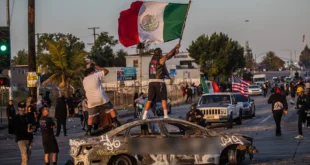Exclusive to Herland Report, the Libyan National People’s Movement analysis of the situation inside Libya, actualized by ICC overturning Saif al-Islam Gaddafi case to Libya, as Libya Militia Prisons hold thousands of prisoners unlawfully.
The international intervention in Libya destroyed the State, including but not limited to, all military and security institutions, local and central government authorities and, the cultural value system. (First published in March, 2018.)
Thus, armed militias assumed control in different regions of the country causing a state of chaos that led to many risks at the national level and on the neighboring countries, the region, and the world at large.
Saadi Gaddafi is, for example, still imprisoned in Libya even if acquitted by the Libyan courts, reportedly held under the authority of the Western backed militia groups, in clear violation of the Geneva convention and international law.
The militia gangs hold prisons all over Libya, many of whom were first held in the notorious El Hadba prison in Tripoli under the militia rule of Khaled Echerif, and later moved under the authority of militia leader, Haytam Etajouri. The militias consist of criminal gangs who were driven out of prisons after the fall of Tripoli, 2011 and are not stopped by NATO or the Western backed government.
The Libyan National People’s Movement analysis continued: Utter chaos characterizes the political situation in Libya. This is evident in a total collapse of the central governing systems and the cultural values’ system; the spread of financial and administrative corruption;
and complete inability to form a central authority despite the media hype and the attempts to portray the situation as normal. The actual reality on the ground is the control of extremist terrorist groups and criminal gangs.
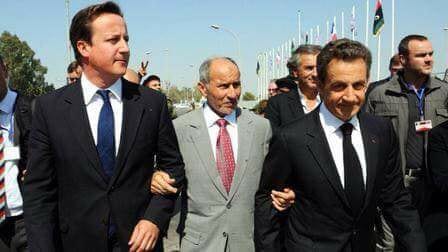
That the United Nations’ efforts in the patronage of a dialogue between some political parties through its international envoy and his associated team did not produce a viable solution because of certain deviations in the process and because of many flaws in the foundations of the dialogue.
The most important of such flaws is inviting certain parties to participate and excluding a wide spectrum of the components of the Libyan people and its political forces and; granting legitimacy to the armed militias and integrating them into the dialogue process in a clear violation of Security Council resolutions, which consider those militias banned terrorist organizations.
RELATED ARTICLES:
- Unattainable dream of freedom for Libya, without Western interference.
- Under autocratic Muammar Gaddafi, Libya was Africa’s richest welfare state.
- Memorandum on Libya: Fabrications against the State – Saif al-Islam Gaddafi.
- Horrifying Militia Rule in Libya post NATO assault 2011. An analysis.
- Media lies about Libya War: Sarkozy, Gaddafi and exile Libyans’ role.
The attempts to establish a central unified authority has failed since the 2012 elections, in which most Libyans were denied participation as nominees nor electors due to the law of political seclusion imposed by the terrorists by force.
The House of Representatives, which was elected in 2014 could not control country because the militants refused to submit to its authority and because of the double-standard policies of the major countries, which insisted on the imposition of terrorist militias to participate in the government.
The General Secretary’s envoy has tried in vain to form and enable a so-called reconciliation government, but this and the other multiple governments existing in Libya will remain a mock-up and will not have any authority on the ground due to the control of militant groups of the reins of the country.

The following is a summarized account of the identity of the armed militias in control of the volatile situation in Libya:
The Political Groups Disguised by the Islamic Religion
These groups are the main force in control of most of the cities and regions of Libya: on the ground, decision-making and resources-wise.
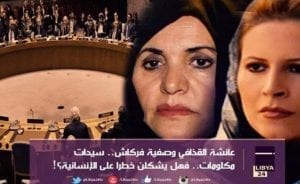
They form the most important armed militia consisting of extremist terrorist groups such as the Islamic Fighting Group, Ansar al-Sharia (aka al-Qaida), Daesh Organization, and, the Organization of Muslim Brotherhood.
These organizations control important cities like Misurata, Derna, Benghazi, Tajura, Tripoli, al-Zawia, and Sirte.
Some of these organizations possess a large armed force so-called “shields”, an armed paramilitary force parallel to the Army and composed of members of the extremist Islamic organizations, and led by known extremist terrorist personalities.
They managed to take complete control of all security services, “the General Intelligence Service, the security committees, the Ministry of Interior, thereby appropriating the state’s resources for their own goals.
Militias of Organized Crime Gangs
The militias consist of criminal gangs who were driven out of prisons after the fall of Tripoli and that captured a sizable quantity of arms, forming secure areas for them in neighbourhoods and villages in different places in the Capital city.
These gangs represent a fundamental force of real power on the ground and possess the presiding force in the running of the country.
There are also the regional militias, which has large military forces and manage important areas. These include the militias of Misurata, Zintan militias and militias of Ajdabiya, which control the oil triangle in Libya.
RELATED ARTICLES:
- Libyan State Institutions overruled by Militia Gang Rule?
- NATO chief, Jens Stoltenberg says he would gladly crush Libya again. #HillaryClinton #Sarkozy.
- Libya Militia Prisons hold thousands unlawfully # Saadi Gaddafi
Since the fall of Libya in the hands of terrorist militias the security situation in Libya is characterized as follows:

1. Due to the proliferation of arms spread, a terrifying level of crime has developed in all its kinds and forms including kidnapping, robbery, extortion, murder and management of secret prisons.
2. Incarceration of many citizens, including more than two thousand women, elderly, centrist clerics, Salafists, and academicians unlawfully only for being charged of supporting the former regime, in prisons run by teenagers. Libya Militia Prisons hold thousands of prisoners unlawfully.
Practically all the arrests were made outside the framework of law and without the knowledge of the prosecutor. The detainees are subjected to forms of torture unknown to humanity in the modern ages.
Such forms of torment include agony by khazouq, cooking the accused alive in huge pots, beating to death, the use of electricity, and so on. Recorded clips of real torture of known people who died under torture.
3. Spread of prisons into residential neighbourhoods, at the outskirts of the Capital, without the moot authorities being able to get access to them let alone controlling them. The number of detention centres amount to more than 700 prisons managed by militias without any legal or ethical controls. About 200 of these centres are fully beyond state control, while the rest are only formally under the authority of the state.
4. The founding of armed militias that seized control of neighbourhoods, streets, and villages leading to a repetition of armed conflicts amongst them; the loss of many innocent lives and the apparent absence of the judiciary and police and, disabling the functioning of laws. Thus, spread in the Capital Tripoli, Benghazi, and various cities acts of murder, looting, armed robbery, kidnapping, enforced disappearance, and even the targeting and assassination of judges and police.
5. Lack of executive power nor a police establishment that would protect the sovereign vital facilities, airports and, borders.
6. Outbreak of tribal conflicts and dissemination of seditions and tribal feuds in a way unknown in Libyan history.
7. Proliferation of drug trafficking, ammunition, and weapons across the border, as well as the massive smuggling of heavy weapons. military vehicles, light army vehicles and, drugs across the Sahel and Sahara region.
8. Control of Daesh organization, Al Qaeda, and the Libyan Islamic Fighting Group, which constitute the main threat to national, regional, and international security on the most important military and security joints in Libya.
9. Libya is realistically semi-independent rival states run by militias not linked to the central authority. This predicament led to the escalation of regional separatist claims that pose a threat to the unity of Libya and the regional hemisphere as a result of the emergence of lax states, which be a haven for terrorism, al Qaeda and Daesh.
10. Proliferation of illegal immigration from Africa to Europe through Libya smuggled by terrorist gangs across the Mediterranean Sea.
The Economic Situation
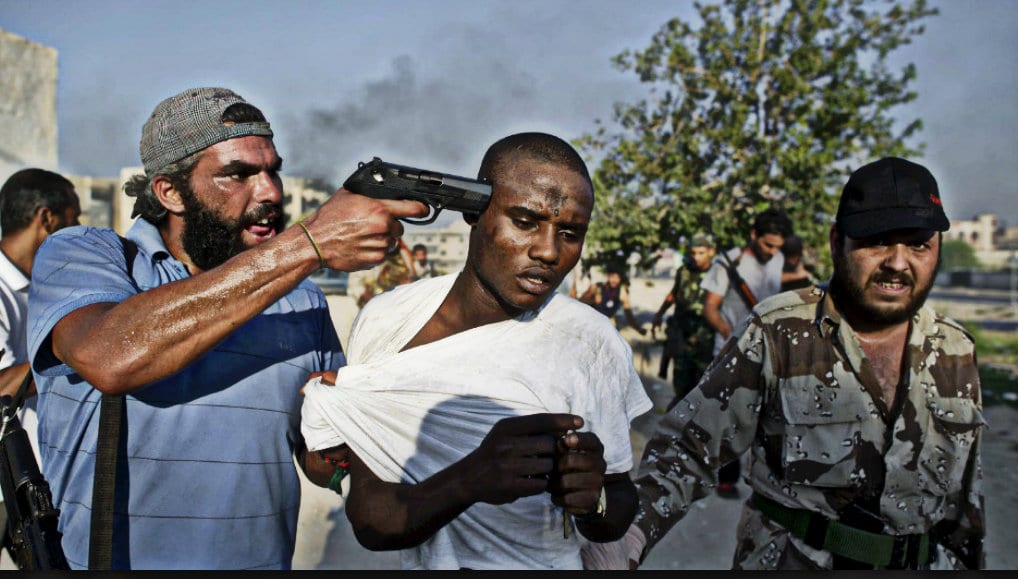
Libya is going through a comprehensive economic paralysis. This is evident in broad looting of money and wealth; devastation of entire infrastructure; collapse of local currency; an explicit rise of prices; and a sharp drop in the level of income of individuals.
RELATED ARTICLES:
- The New Libya, the return of a Gaddafi? Hanne Herland, WND.
- Gaddafi wife, Safia Farkash and daughter, Aisha Gaddafi still under travel ban, accounts closed.
- Power vacuum in US, Europe, Israel emboldens Ottoman Erdogan in Libya.
This foreshadows of a looming humanitarian catastrophe where the specter of hunger casts a shadow over the country. Following is a sum up of the economic situation in Libya:
1. Destruction of infrastructure, civilian and military installations and service and productivity establishments; and cessation of development projects that were almost completed ahead of the tragic February 2011 events.
2. Systematic looting of oil wealth by local militias and international mafia, thereby, ending the flow of oil revenues to the public treasury, with serious negative effects on the living index of the Libyans and the Libyan household economy.
3. Wasting of public money through serious financial excesses, irresponsible monetary policies, and attempts of international mafia to get access to and loot Libyan frozen funds and Libyan investments abroad.
4. Stealing of huge sums of money from banks, insurance companies, and funds that were paid salaries of pensioners, the unemployed and low-income people.
5. Collapse of the banking system and the start of the conclusion of dubious agreements within the framework of rewarding the allies in the war on Libya.
6. Disruption of export and import lines; forcing dealers and suppliers to pay additional fees and/or unlawfully taking away of their goods by the militias; and non-arrival of goods to the towns and villages situated far away from the ports because of the collapse of the internal transport system.
Media and Cultural Situation
The domination of the culture of extremism characterizes the media discourse and cultural orientation in Libya. Following is a synopsis of the daily scene in the Libyan media:
1. Control of militants disguised in Islamic religion orientations on mosques and radio stations, and the dissemination of extremist associations in universities and institutions of education.
2. Assault on the sanctity of graves through repeated attacks on religious shrines, digging up graves dating back hundreds of years, in addition to the attacking of Egyptian Coptic citizens and executing a sizable number of them in cold blood in a manner that is abusive to the teachings of our Islamic religion, and the tolerant Libyan Arab customs and traditions.
3. Domination of a rang hollow media discourse that impedes all attempts at a comprehensive national dialogue and comprehensive reconciliation.
4. The arrest and torture of large numbers of media personalities who are anti-extremism, terrorism, foreign interference and, the power of terrorist militias.
5. Pressuring other countries and threating them to ban broadcasting of satellite channels airing an anti-militias media discourse.
The Humanitarian and Health Situation
The humanitarian, social and health problems exacerbated to a level that led regional and international humanitarian organizations warn of the consequences of the situation.
Following are examples of some of these problems:
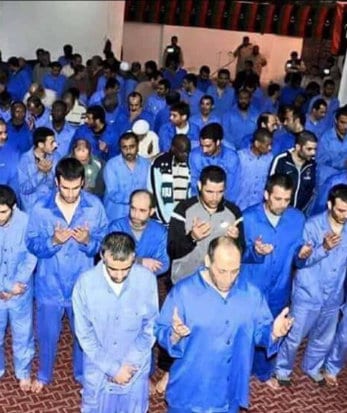
- The militia gangs hold prisons all over Libya, many of whom were first held in the notorious El Hadba prison in Tripoli. Photo of praying prisoners from El Hadba. Herland Report.
1. Dislodging of more than one million and three hundred thousand (1,300,000) Libyan citizens inside Libya, a high percentage compared to the number of Libya’s population that barely exceeds five million from their towns and villages, including Tawergha, al-Koalesh, al-Aweiniyah, Tuminah, al-kararim.
The dislodged are housed in unsafe make-shift camps in poor humanitarian conditions that lack facilities of appropriate health care and education.
2. Exposure of the unguarded camps of the dislodged to multiple incursions and gross violations of their rights, which calls for quick international intervention to protect them and take them back to their towns and villages and compensate them for their homes.
3. Preventing international organizations such as the Red cross and other organizations from visiting the camps of the dislodged and the devastated regions to conceal revenge operations and deliberate liquidation.
4. Selective media coverage of the tragedy of the dislodged at home and the displaced abroad and considering them enemies who must be politically excluded and ill-treated if they are at home, or handed over by the countries hosting them if they are abroad on the pretext that they are supporters of the former regime after being bogusly charged.
5. Proliferation of murder, torture, forced displacement and looting of private property, in addition to launching of teenagers and former prisoners to loot the homes and property of citizens without accountability or punishment protected by some fatwas that allow such actions for takfiri reasons that legitimize rape and violation of funds and honor under the umbrella of religion.
6. Absence of justice in dealing with those killed or wounded based on tribal and regional affiliation led to the outbreak of fighting in Kufra, Sabha, Benghazi, and others.
7. Relocation of more than two million displaced Libyans to neighboring countries, Egypt, Tunisia, Algeria, Niger, Chad, and Morocco. The official statistics issued by the host countries indicate that nearly one million relocated to Egypt, and more than 600 thousand to Tunisia, and the rest to Niger, Chad and Algeria, Morocco, Europe, and the rest of the African countries.
8. The humanitarian suffering of the displaced and their families and their inability to bear the costs of education and health care on their own puts hundreds of thousands of Libyan children in serious humanitarian conditions that threaten the future of the generations to come. In this regard, we must say that the refugee and childhood bodies of the United Nations have not shown any interest in this humanitarian problem, nor did the United Nations organizations and its sub-organizations recognize their humanitarian status as refugees.
9. Exacerbation of racial discrimination against black Libyans, accusing them of being foreign mercenaries and, the adoption of racist ideas by criminal militia leaders.
10. Deterioration of standards, and selective procedures against all Libyans who are associated and affiliated with the former regime and preventing them from running in the elections. Such procedures perpetuate hatred, thwarts reconciliation and weakens popular representation through emptying the cities from their elites, intellectuals, and cadres under the pretext of belonging to the previous regime.
11. Issuing of laws that violate human rights and contravene conventions, treaties, and protocols to which Libya is a party.
12. Near total collapse of the health system due to the dangerous security situation; the scarcity of medicines and medical supplies; and the inability of medical personnel to assume their responsibilities.
13. Collapse of the education system, and the inability of hundreds of thousands of Libyan children to attend school because of the security conditions, and because of the dislodging and displacement of more than three million Libyans at home and abroad.
14. Crash of internal and external transport systems because of the security situation, lack of fuel and; locking of almost all air transport with most the countries of the world after the burning and destruction of the major airports in the country and the high risks to shipping. This, in turn, has had a negative impact on production, services and, distribution sectors.
15. Deterioration of financial incomes of individuals because of the halt in paying the monthly salaries of the employees, the inability of people to withdraw needed amounts from their accounts, the rise of the exchange rate of the dinar against hard currencies and, discontinuing the investment portfolios, which the state used to allot to the poor and low-income families.
16. Collapse of the electricity system because of lack of financial liquidity needed for running the stations, messing around with electricity stations by militias and, stealing the electric wires and selling them as copper. Such collapse has caused power outages for long periods, reaching most times several days, with an impact on the lives of individuals and on health, production, and services sectors.
The tribe still plays a key role in political and social life despite the shrinking of its influence over the past decades. The conflict in Libya led to serious tribal divisions and violent tribal conflict that threatens a devastating civil war because the tribes split between a majority that supports the former regime and a pro-February regime.
Also check out these topics at CNN or FOX News. Other sources may be New York Times, USA Today, the Washington Post or from the British angle, BBC, The Guardian, The Telegraph or Financial Times.









